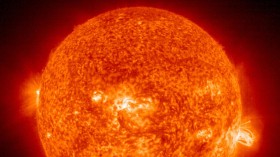A new study based on ancient fossilized leaves retrieved from a lake bed in New Zealand provides new evidence that the sudden increase of carbon dioxide concentration in the atmosphere is responsible for the historic shrinking of the Antarctic ice sheet.
The study, published in the journal Earth and Planetary Science Letters, revealed that the levels of carbon dioxide in the atmosphere have increased dramatically over a relatively short period of time as the ice sheet began to shrink.
The Antarctic ice sheets experience a dramatic decrease during the transition between the Oligocene and Miocene period. Within the 100,000-year period, the ice sheets in the Antarctic region have gone from 125 percent larger than it is today at the beginning to 50 percent smaller than today by the end of the period.
"We see here that when the Antarctic ice sheet starts deteriorating, it is not that easy to get it back," said Tammo Reichgelt, a postdoctoral research scientist at Columbia University's Lamont-Doherty Earth Observatory and lead author of the study, in a statement. "Some models have shown that, at the rate we're going right now, the Antarctic Ice Sheet might reach a critical tipping point and start reducing the extent of ice very quickly. We see here that that has happened in the past."
For the study, the researchers analyzed fossilized leaves recovered from the bottom of ancient lake on New Zealand's South Islands. Using the number of stomata openings and carbon isotopes composition of the leaves, the researchers were able to estimate the carbon dioxide concentration in the atmosphere 23 million years ago.
The researchers discovered that before the historic shrinking of the Antarctic ice sheets began, the atmospheric carbon dioxide levels increased from 500 parts per million (PPM) to between 750 and 1550 PPM. After 20,000 years, the atmospheric carbon dioxide levels dropped to around 425 PPM but positive feedback loops continued to drive melting.
With their findings, scientists are alarmed that 750 PPM of carbon dioxide levels in the atmosphere could destabilize the Antarctic ice sheet. Especially now that the atmospheric carbon dioxide levels have already exceeded the 400 PPM mark.
© 2024 NatureWorldNews.com All rights reserved. Do not reproduce without permission.
![Severe Thunderstorm Alert: Tornadoes, Damaging Winds and Hail Possible from Upper Ohio Valley to Northeast US [NWS]](https://1471793142.rsc.cdn77.org/data/thumbs/full/70161/280/157/50/40/severe-thunderstorm-alert-tornadoes-damaging-winds-and-hail-possible-from-upper-ohio-valley-to-northeast-us-nws.jpg)




